

Another busy week for The English Apple Man with farm walks and a visit to East Anglia
But returning to the HDC/EMR top fruit day on 24th April 2014; the afternoon session, Chaired by EMR Press Officer - Ross Newham produced a lot of very interesting and useful information.
 Rhyncites
Rhyncites
Apple Fruit Rynchites Weevil was the first subject, presented by Bethan Shaw.
This project looks at the 'feasibility of developing a semiochemical based monitoring trap' for apple fruit rhynchites. Semiochemicals are nature's message-bearing molecules that are used as signals by a variety of organisms.
AFR is a common pest of apple and pear and has wild hosts. The adults feed on young fruitlets, buds, shoots and flowers. Eggs are laid singly in fruitlets.
Losses caused by AFR can be between !% - 5% in apple orchards.Control with thiacoprid (Calypso) during or after flower is the effective treatment. Currently there are no reliable monitoring methods, so a specific monitoring trap would be a valuable tool.
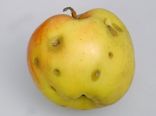 Beth said the objectives were: (1) To determine whether sexual attraction occurs between male and female AFR, which sex is attractive and the time that attraction occurs. (2) Use chemical and electroantennogram analysis (EAG) to determine whether any candidate compounds can readily be detected or identified.
Beth said the objectives were: (1) To determine whether sexual attraction occurs between male and female AFR, which sex is attractive and the time that attraction occurs. (2) Use chemical and electroantennogram analysis (EAG) to determine whether any candidate compounds can readily be detected or identified.
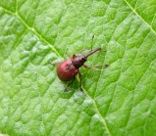 The 'answer' to the question of whether attraction between males and females occurs in the field was sought by trialing 'live weevils' in tea infusers used as bait, using 3 different sampling techniques; 'beat sampling' - 'delta trap' - 'x-vane trap' and the sex of the weevil determined + the relationship between sex of bait weevil and catches!
The 'answer' to the question of whether attraction between males and females occurs in the field was sought by trialing 'live weevils' in tea infusers used as bait, using 3 different sampling techniques; 'beat sampling' - 'delta trap' - 'x-vane trap' and the sex of the weevil determined + the relationship between sex of bait weevil and catches!
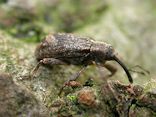 Sexual attraction in the laboratory Observations were recorded, using live weevil taken from hawthorn and apple hosts, and mixed rearing boxes of males and females, with either apple or hawthorn as food.
Sexual attraction in the laboratory Observations were recorded, using live weevil taken from hawthorn and apple hosts, and mixed rearing boxes of males and females, with either apple or hawthorn as food.
'Male and Females' were able to identify each other; mating and egg laying take place in unison as the male mounts the female 'during' the egg laying. The weevils then set about drilling holes into the stem of the fruitlet, assisting severing the stem resulting in most fruits falling to the ground allowing the weevil cycle to start all over again.
Summary
Methods of 'sexing' adults developed; Severing and egg laying in apple fruits observed; AFR is breeding in apple orchards, but we don't see eggs/larvae in fruits because of 'severing' - Wild hosts are not an essential source of infestation.
There is some evidence of female attraction to males? Results are encouraging; the focus in 2014 will be the use of 'beat' sampling. Further work on chemical analysis and EAG for sex specific compounds is in progress now!
Earwigs
 Dr. Michelle Fountain presented the further development of Earwig safe spray programmes for apple and pear orchards.
Dr. Michelle Fountain presented the further development of Earwig safe spray programmes for apple and pear orchards.
 Earwigs are our friends; 'voracious nocturnal predators of aphids, sucker nymphs and eggs, caterpillars, codling eggs, larvae, and pupae etc.
Earwigs are our friends; 'voracious nocturnal predators of aphids, sucker nymphs and eggs, caterpillars, codling eggs, larvae, and pupae etc.
Earwigs are 'night active' but there are large variations in earwig populations and earwigs are low or even absent in many orchards.
Current earwig research projects at EMR.
HDC project TF196 - Investigation of the effects of commonly used insecticides on earwigs. HDC project TF220 - Further development of earwig-safe spray programmes for apple and pear orchards.
Laboratory test methods used; 10 reps. Nymphs, Males, Females. A Burkard computer controlled sprayer. Weekly assessments of survival and behaviour changes.
Laboratory treatments using commonly used insecticides + a coded material and an untreated control, produced results of 'end survival' and 'mobility' of nymphs and adult earwigs after exposure to insecticides.
Field tests followed using a motorised knapsack sprayer on a 'randomised' complete block, using 4 reps; 6 trees per plot, recording the numbers in each refuge from night assessments (30 counts)
Conclusions after year 2; 'early season and day time application may reduce harmfulness of some insecticides. Harmfulness may also depend on conditions and method of application.
In year 3; Earwig compatible v standard spray programmes compared in field trials, on 2 commercial farms. The comparison between the 2 farms produced a very interesting result. One farm started with a very high population of earwigs, the other very low; the assessment at the end on each farm showed a considerable increase in earwig population on both farms,but by the end of August the 'well populated' farm from the initial assessment had very high numbers of earwigs, irrespective of 'conventional or friendly' chemical use. The conclusion is that the use of 'earwig compatible' programmes allowed the build up of earwig numbers across the season. But once large populations are established - 'occasional conventional sprays' may be acceptable.
Summary
'Look after your earwigs' in orchards; assess populations in orchards with 'bottle' refuges; look for earwigs 'after dusk on warm summer' evenings; avoid using pesticides - harmful to earwigs at key times of the year.
KEY 'Spring nesting females' in trees - May onward's young earwigs in trees. Avoid soil disturbance in winter!
Irrigation strategies
 Mark Else - EMR
Mark Else - EMR
Mark presented the latest news on 'Sustainable irrigation of high-intensity tree fruit orchards'
The English Apple Man comments: Water availability is an important subject for future food production; 'possibly THE most important element' in the challenge to produce enough food to feed our 'ever increasing' global population.
HDC Projects: TF198 - Conference Pears; 2011-2013 & TF210 - Braeburn and Gala; 2013-2016 seek the answers to 'improving use efficiency product quality' by targeting 'efficient irrigation scheduling' - 'matching demand with supply' - 'increasing water and fertiliser productivity' - 'improving substrate water holding capacity' - 'scheduling tools for growers'
Using deficit irrigation regimes; RDI (regulated deficit irrigation) and PDI (partial root drying) novel irrigation regimes - manipulating 'in planta' chemical signals to develop improved quality and shelf-life of product, the research seeks the optimum use of water.
Below data from HDC website
76% of growers in England and Wales farm in areas currently classified as being under 'water stress'. With additional pressures resulting from climate change and the need for greater production agricultural water demand is predicted to increase from between 25% to 180% of current demand by the 2050's, at a time when its availability for horticulture is becoming limited. Many growers continue to apply 'insurance' irrigation to high value crops but with rising costs and the potential for run-off of fertilisers and pesticides to pollute ground and surface waters current practices are unsustainable.
A new water saving 'irrigation test regime' (ITR) was developed for 'high intensity' pear production' in Project- TF198. Water savings of over 50% have been achieved compared to 'commercial controls' (CC) without loss of yield or quality.
Project 198 - Conference Pears; demonstrated no staistically significant difference in yield, or Brix value, colour, firmness or russetting, but measured by water productivity values: CC = 25 to 38 litres per kg of Grade 1 fruit. ITR = 5 to 13 litres per kg Grade 1 fruit.
The project clearly demonstrates the massive potential for water saving, without reducing the quantity and quality of the fruit.
In Project TF210 - Braeburn & Gala the 'tree physiological' responses to limited water availability are being sought.
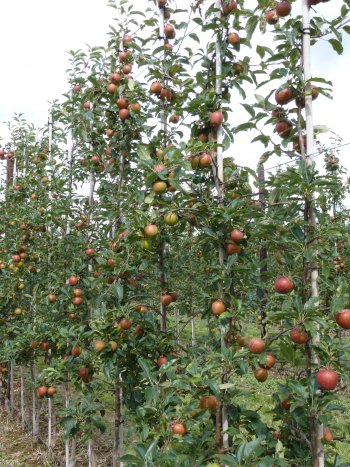 Fruit Walls
Fruit Walls
 Tim Biddlecombe - FAST MD
Tim Biddlecombe - FAST MD
Tim reported on the progress of HDC Fruit Wall Trials.
Key objectives; Time of pruning - 'winter' - 'pink bud' - 6,9, or 12 leaves (stage)
Type of tree; 'Knip tree' - 'Grow through' - 'Maiden' - '8 month' - 'Twin stem'
To determine the 'optimum' time of pruning, evaluating its effect on 'Yield and Maturity' - 'Fruit size' - 'Fruit quality' - e.g. 'Colour' - 'Sugars' - and 'Firmness' and by monitoring 'Leaf and Fruit analysis' the optimum timing can be identified.
The physical aspects of research involved winter hand pruning, and machine pruning at the various 'stages' e.g. Pink bud, 6, 9, and 12 leaf stages.
The 'hand pruning' concentrates on removing "Antler" branches at the top of the tree - 'Overcrowded branches' - 'Strong upright branches' and 'Low hanging' branches.
Quite apart from the quality requirements vital to consumer expectation, the effects on mineral content were assessed.
Leaf analysis showed a reduction in Nitrogen (N) from 2.50% to 2.03% in cuts at the 6 & 9 leaf stages. Magnesium (Mg) also reduced from 0.21% to 0.15%. Calcium (Ca) and Manganese (Mn) was lowest in trees pruned at 6 leaf stage. Boron (B) was lower in winter and pink bud pruned trees.
Tim Biddlecombe's conclusions
* Prune at later stages for best growth control.
* Late summer cut can reduce yield.
* Fruit size very sensitive to fruit numbers on the tree.
* Less effect of late cuts on sugar and firmness in 2013 than in 2012.
* Inter tree pruning provides positive effects in fruit size and colour.
* Leaf N, Mg, and Ca reduced in summer cuts in 2013, but mineral fruit content not affected significantly.
Cherry Breeding - Linkage Map
Emma Skipper - EMR
 Emma presented the latest position in: The Application of Linkage Map Construction in Cherry Breeding.
Emma presented the latest position in: The Application of Linkage Map Construction in Cherry Breeding.
Looking at Linkage maps; what are they? How are they constructed ?
'Colney x C21007 linkage map' 'Improved quality' traits.
A 'Linkage Map' is used to represent the 'gene' and/or 'molecular marker' order along a chromosome.
The order is shown in linkage groups and is based on recombination frequency.
It is a tool to locate gene(s) or regions containing genes responsible for genetic variation of a trait.
Using Colney x C210-7 (Lapins x Sweet September) 337 seedlings were assessed for variation in maturity dates, differences for fruit quality traits: 'size' - 'colour' and 'firmness'
The full presentation is too complex to report in full, but the search for optimum fruit quality and size involves utilizing genetic markers to create a map of beneficial traits. The benefit in 'marker assisted breeding' enables an 'informed choice' of parents for breeding. Early screening of germplasm (in the greenhouse) a reduction in field costs and an accelerated breeding cycle.
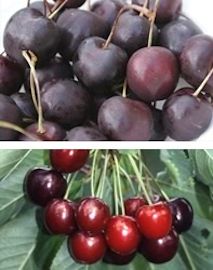 The next generation of Cherry varieties
The next generation of Cherry varieties
Feli Fernandez - EMR
 Feli gave an overview of Cherry Breeding at EMR; rootstock development has 'historically' majored on apple rootstocks, with just 4 cherry rootstocks released between 1924 -1986. A publicly funded UK programme and breeding programme was run at John Innes institute from 1921. In 1980's a consolidation of research institutes resulted in the JI cherry germplasm and breeding programme moving to East Malling.
Feli gave an overview of Cherry Breeding at EMR; rootstock development has 'historically' majored on apple rootstocks, with just 4 cherry rootstocks released between 1924 -1986. A publicly funded UK programme and breeding programme was run at John Innes institute from 1921. In 1980's a consolidation of research institutes resulted in the JI cherry germplasm and breeding programme moving to East Malling.
Recently; DEFRA funded stone fruit breeding & development programme (2003 - 2008) set out to; extend the season for late ripening cherries - improve reliable cropping & good quality - improve sustainable production, with more natural resistance to canker & black fly and develop greater use of molecular markers.
Two of the successful varieties coming out of the cherry breeding programme at EMR are PENNY & ZOE.
On Tuesday 29th April The English Apple Man joined a large group of EKFS (East Kent Fruit Society) members at Highland Court Farm at Bridge near Canterbury in East Kent for a blossom walk. Our hosts; FARMCARE Ltd.
The task of picking the right day for a blossom walk back in the depths of winter, is a bit like buying a lottery ticket; 'well the EKFS committee' hit the jackpot by picking a perfect day with good weather and a very good show of blossom.
Three years ago the Cooperative Farms agreed to lease Highland Court for a period of 20 years. From day 1 the set about modernising the orchards. Since then over 80 hectares of new orchards have been planted.
The Highland Court tenancy amounts to 264 hectares across 5 sites in East Kent. The major production unit is at Highland Court with 120 hectares. Apples are the predominant crop with 112 hectares, Blackcurrants with 75 hectares are the next in line and pears, plums, cherries, walnuts, apricots and a PYO (pick your own) enterprise with Strawberries, Cherries, Plums, and Cane fruit complete the production areas.
New Plantings
Spring 2011 - 19.5 hectares of Gala & Braeburn.
Spring 2012 - 19 hectares of Gala & Sweetie.
Spring 2013 - 18.1 hectares of Gala, Braeburn & Sweetie
Spring 2014 - 14.5 hectares of Gala, Braeburn, Early Windsor and Opal.
Spring 2015 - 4.2 hectares of Junami (planned)
The projected top fruit volumes (apples & pears) rise from circa 1100 tonnes in 2010 to 3,800 tonnes by 2015 and level off at just short of 5,000 tonnes in 2019.
The varietal 'apple' mix by percentage in 2019: Gala 35% - Braeburn 30% - Sweetie 7% - Bramley 6% - Junami 4% - Opal 3% - Early Windsor 2% - Cox 2% - Egremont Russet 2% - Juice 7% + oddments 2%.
Add Conference, Comice, Concorde & Williams Pears, Victoria & Marjorie Plums, Penny, Skeena, Sweetheart, Merchant, and lapins Cherries.
The transformation from the Spring of 2011 is staggering and a credit to the management of Sean Finlayson and his team. The quality of management in all the orchards is very high and the new plantings as 'good as you can get'
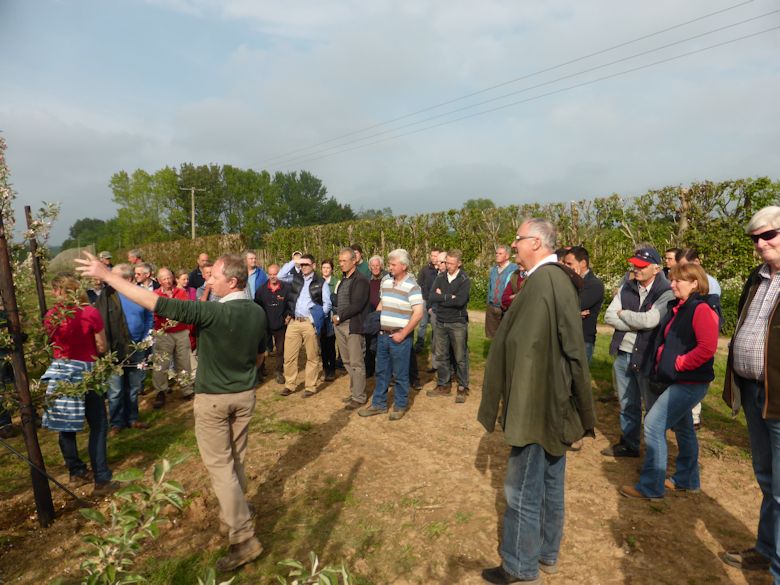
.jpg)
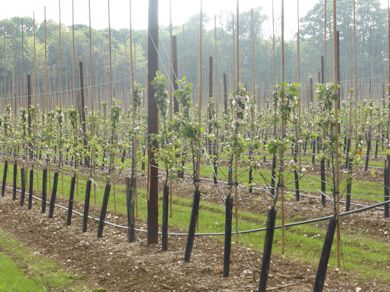
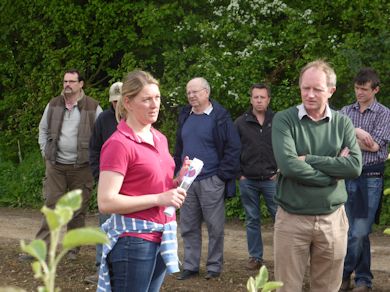
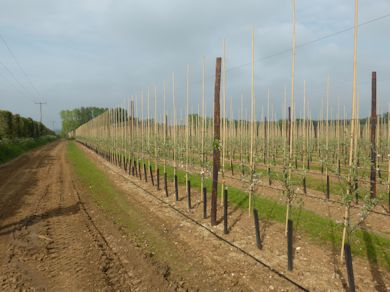
Click to visit The Cooperative website
Following our walk around Highland Court orchards, we enjoyed 'barbecued burgers' and a beer in the spectacular surroundings of St.Lawrence Cricket Club which is located in the grounds of the Highland Court Estate.
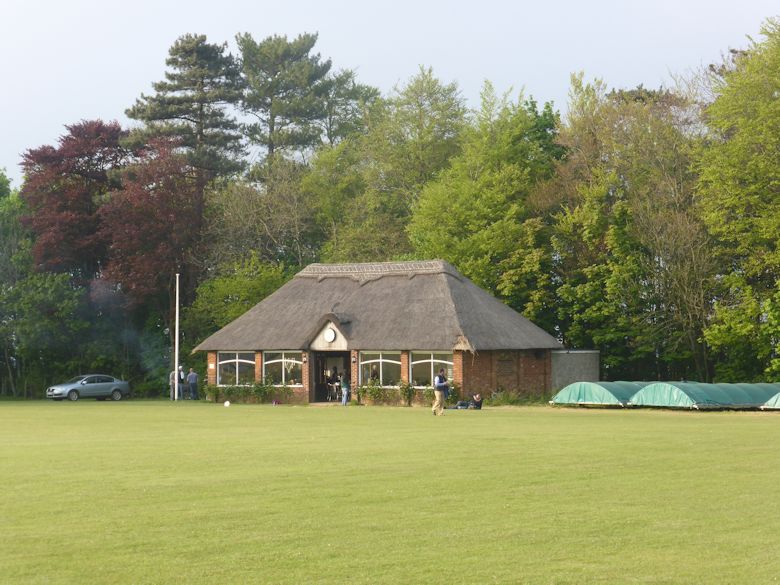
Click to view St.Lawrence Cricket Club website
That is all for this week........next week The English Apple Man will report on visits to Griffin Farm at Sutton Valence and Wilkins at Tiptree, makers of the highest quality jams for well over 100 years...
Take care
The English Apple Man